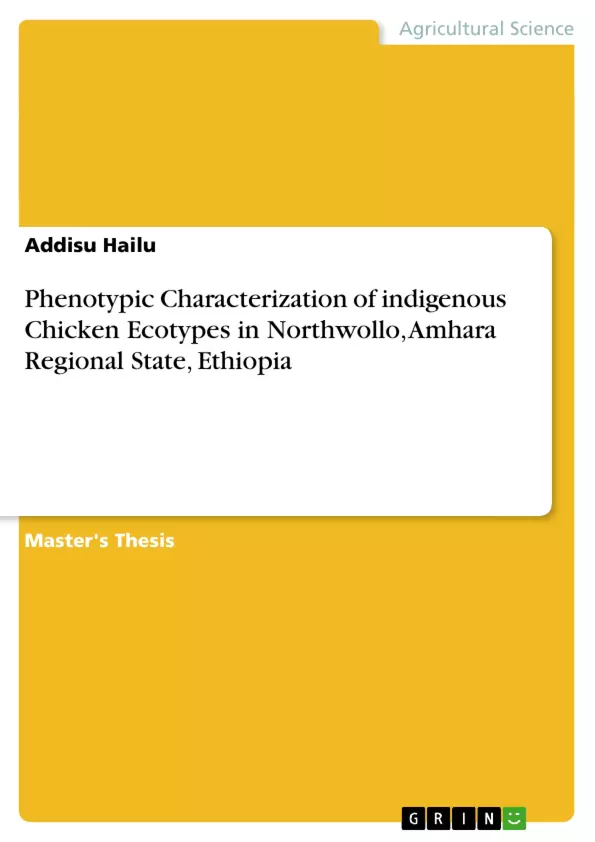ABSTRACT
Phenotypic characterization of indigenous chicken ecotypes was conducted in North Wollo from January 2011 to May 2012 with the objectives of characterizing indigenous chicken and their production system. Simultaneously, identification of development intervention for improved utilization of chicken genetic resources was also identified. In the first part of data collection, one focused group discussion per agro-ecological zones was held. Then, administration of well-structured questionnaire and morphometric measurement were employed. Measured quantitative traits of chicken among the three altitudes were analyzed by linear model of SAS 2002 for male and female chickens separately. Subsequently, mean value of each traits were compared using Tukey’s mean comparison method. Multivariate analysis of principal component analysis, canonical discriminant, step-wise discriminant and clustering analysis was performed by SPSS 19.0 for male and female chicken ecotype separately. Nechi (17.6%), Tikur (12.6%) and Key (10.8%) plumage colour were found dominantly all over the study area. Findings of the focus group discussion revealed that there were morphologically differences among chickens of high altitude, mid altitude and low altitude study areas. Similarly, findings from the semi-structured questioner revealed that indigenous chicken ecotypes are dual-purpose. The critical constraints of scavenging chicken production were disease (60.13%) predators (20.59%) and feed shortage (19.28%). Number of egg lay/clutch (37.91%) and plumage colour (37.58%) were the major preferred trait by the farmers in the study area. For qualitative and quantitative study, 715 sample chickens were recorded by category of agro-ecology. Linear measurements on six traits were taken from 210 mature male and 305 mature female chickens. The overall mean body weight of indigenous male and female chickens was 1500.97gm and 1253.36gm respectively. The overall age at sexual maturity for male and female was 24.25 ± 0.04 and 23.84 ± 0.05 weeks respectively. There was highly significant difference (p<0.0001) in egg production/hen/clutch across altitudes. Based on linear model analysis and result of focus group discussion, observed morphological variation and multivariate analysis, three chicken population found in North Wollo was categorized in to high altitude, mid altitude and low altitude chicken ecotypes.
Inhaltsverzeichnis (Table of Contents)
- Introduction
- Materials and Methods
- Study area
- Study animals
- Data collection
- Morphological traits
- Production traits
- Physiological traits
- Reproductive traits
- Data analysis
- Results and Discussion
- Conclusion and Recommendation
Zielsetzung und Themenschwerpunkte (Objectives and Key Themes)
This thesis examines the phenotypic characteristics of indigenous chicken ecotypes in North Wollo, Amhara Regional State, Ethiopia. The primary objective is to provide a comprehensive understanding of the diversity and potential of these local chicken breeds.
- Morphological characteristics of indigenous chickens
- Production performance of indigenous chickens
- Reproductive performance of indigenous chickens
- Physiological adaptations of indigenous chickens
- Conservation and utilization of indigenous chicken breeds
Zusammenfassung der Kapitel (Chapter Summaries)
The thesis begins with an introduction that sets the context for the study, highlighting the importance of indigenous chicken breeds in Ethiopia. It then delves into the materials and methods used for the research, including the study area, animal selection, and data collection procedures.
The results and discussion section presents the findings of the study, analyzing the morphological, production, reproductive, and physiological traits of the indigenous chicken ecotypes. The final section, the conclusion and recommendation, summarizes the key findings and suggests potential strategies for conserving and utilizing these valuable local breeds.
Schlüsselwörter (Keywords)
This research focuses on the phenotypic characterization of indigenous chicken ecotypes in North Wollo, Ethiopia. Key areas of study include morphological, production, reproductive, and physiological traits. The study also considers the conservation and utilization of these important local breeds for future agricultural development in the region.
- Citation du texte
- Addisu Hailu (Auteur), 2012, Phenotypic Characterization of indigenous Chicken Ecotypes in Northwollo, Amhara Regional State, Ethiopia, Munich, GRIN Verlag, https://www.grin.com/document/206157



